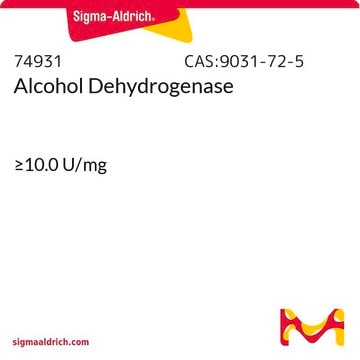Transportation information can be found in Section 14 of the product's (M)SDS.To access the shipping information for this material, use the link on the product detail page for the product.
Kluczowe dokumenty
I8377
Iodonitrotetrazolium chloride
Used in colorimetric assays.
Synonim(y):
2-(4-Iodophenyl)-3-(4-nitrophenyl)-5-phenyl-2H-tetrazolium chloride, p-Iodonitrotetrazolium Violet, INT
Wybierz wielkość
510,00 zł
Wybierz wielkość
About This Item
510,00 zł
Polecane produkty
Poziom jakości
Próba
≥98% (TLC)
Formularz
powder
mp
240 °C (dec.) (lit.)
rozpuszczalność
H2O: 4 mg/mL
Zastosowanie
diagnostic assay manufacturing
hematology
histology
temp. przechowywania
2-8°C
ciąg SMILES
[Cl-].[O-][N+](=O)c1ccc(cc1)-[n+]2nc(nn2-c3ccc(I)cc3)-c4ccccc4
InChI
1S/C19H13IN5O2.ClH/c20-15-6-8-16(9-7-15)23-21-19(14-4-2-1-3-5-14)22-24(23)17-10-12-18(13-11-17)25(26)27;/h1-13H;1H/q+1;/p-1
Klucz InChI
JORABGDXCIBAFL-UHFFFAOYSA-M
Szukasz podobnych produktów? Odwiedź Przewodnik dotyczący porównywania produktów
Powiązane kategorie
produkt powiązany
Hasło ostrzegawcze
Danger
Zwroty wskazujące rodzaj zagrożenia
Zwroty wskazujące środki ostrożności
Klasyfikacja zagrożeń
Flam. Sol. 1 - STOT SE 3
Organy docelowe
Respiratory system
Kod klasy składowania
4.1B - Flammable solid hazardous materials
Klasa zagrożenia wodnego (WGK)
WGK 3
Wybierz jedną z najnowszych wersji:
Certyfikaty analizy (CoA)
Nie widzisz odpowiedniej wersji?
Jeśli potrzebujesz konkretnej wersji, możesz wyszukać konkretny certyfikat według numeru partii lub serii.
Masz już ten produkt?
Dokumenty związane z niedawno zakupionymi produktami zostały zamieszczone w Bibliotece dokumentów.
Klienci oglądali również te produkty
-
What is the Department of Transportation shipping information for this product?
1 answer-
Helpful?
-
-
Is there a reference for using Product I8377, Iodonitrotetrazolium chloride, to treat brain membrane preparations?
1 answer-
Yes. See Neuroscience Letters Volume 35, Issue 2, 21 February 1983, Pages 215-220
Helpful?
-
-
Can Product I8377, Iodonitrotetrazolium chloride, be used for the staining of cells?
1 answer-
Yes, although due to the large crystal size of the formazan and lack of substantivity, histological application of I8377 has been limited. In microbiology, the product was used by Lussenhop and Fogel (1993) for in situ microscopic observation of soil biota.. Gribbon and Barer (1995) used for the demonstration of viable but nonculturable bacteria. Heidelberg (1997) used as a bacterial viability stain.
Helpful?
-
-
Is there a procedure for reducing Product I8377, Iodonitrotetrazolium chloride, by superoxide radicals?
1 answer-
Yes. See Biochem Biophys Res Commun. 1988 Feb 15;150(3):1294-301.
Helpful?
-
-
Is Product I8377, Iodonitrotetrazolium chloride, lipophilic?
1 answer-
Yes, I8377 is a lipophilic cation of moderate size. The resulting formazan is more strongly liophilic and fat soluble.
Helpful?
-
-
Product I8377, Iodonitrotetrazolium chloride, is stated to have solubility in water, ethanol and ethylene glycol monomethylether. What other solutions can be used?
1 answer-
Conn's Biological Stains, 10th Edition (page 163) states P-Iodonitrotetrazolium Violet is also soluble in dimethylsulfoxide and dimethylsulfoxide-water mixtures.
Helpful?
-
Active Filters
Nasz zespół naukowców ma doświadczenie we wszystkich obszarach badań, w tym w naukach przyrodniczych, materiałoznawstwie, syntezie chemicznej, chromatografii, analityce i wielu innych dziedzinach.
Skontaktuj się z zespołem ds. pomocy technicznej













